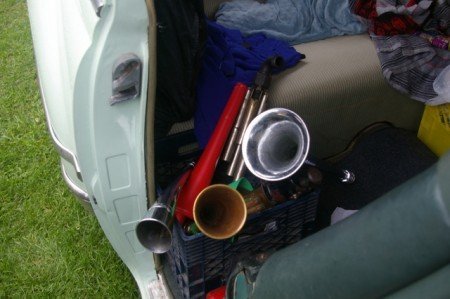Car Collector’s Corner: Honk If You Love The Classic Sound Of A Real Car Horn

They were invented to warn drivers of other drivers on the road. Horns were also invented to assist the middle finger in descriptive impromptu editorials that register drivers’ displeasure with other drivers on the road, and to engage in general non-verbal communication with other traffic participants.. History does not appear to have recorded the chicken/egg side of the equation which would sort out which came first in the automobile horn/middle finger debate.
Car horns have saved lives and cost teeth, depending upon the traffic circumstances and emotional control of drivers. An errant car horn can be an instant turbo-boost to uncontrollable road rage under the right conditions, but we still love them.
Let’s see how much we do.

The early days of automobiles featured a variety of choices like the bulb horn, the Gabriele and Klaxon horn, but the “Ahooga” sound of the Model T remains one of the most famous horn sounds. It sounded like a comedy noise from a cartoon even before we had cartoons.
I am not old enough to know whether a T horn blast at another driver produced road rage or a hearty round of laughter, but it would be difficult for me to get angry if I was the object of an angry Model T horn blast. Too many years of Bugs Bunny cartoons have made that sound mission impossible for an angry outburst from me.
I guess the same could be applied to the Chihuahua sound of a small car horn. A beep-beep horn means a beep-beep sized car and it does not provoke anger unless the beep-beep driver leans on his horn without a break in the action.
Then the horn honker gets the same reaction as a yappy Chihuahua. Eventually, tensions will rise to the breaking point, and you will have to resist a strong urge to bring some serious unhappiness into the car driver’s or small dog’s lives.
The exception to the beep-beep rule has to be the 1968 Plymouth Road Runner. The smallest engine even available in this bird was a big block 383 Magnum, and the limited menu of other ‘Runner choices were the ultra-macho 440 and 426 Hemi options.

The Plymouth Road Runner may have had a beep-beep horn, but it was very capable of settling scores on the street right out of the showroom. The rumble of the exhaust from these cars when they were in pedal-to-the-metal street battle mode probably rendered the beep-beep horn somewhat irrelevant in the bigger picture.
Most car guys still crave the big horn sound found in most North American cars from the golden post war era of the 40s, 50s, and 60s. These babies were noise-makers of the first order, and sounded like a slightly modified train horn on some cars.
The classic car horns were big, bad and beautiful when they were unleashed on the roads of yesteryear. Maybe they were unable to wake up the dead, but they came closer than any séance.

So let us celebrate the life, and mourn the passing of the classic car horns from the past. They were great while they lasted and so were the front teeth of people who used the horns too much.
Nouvelles connexes


